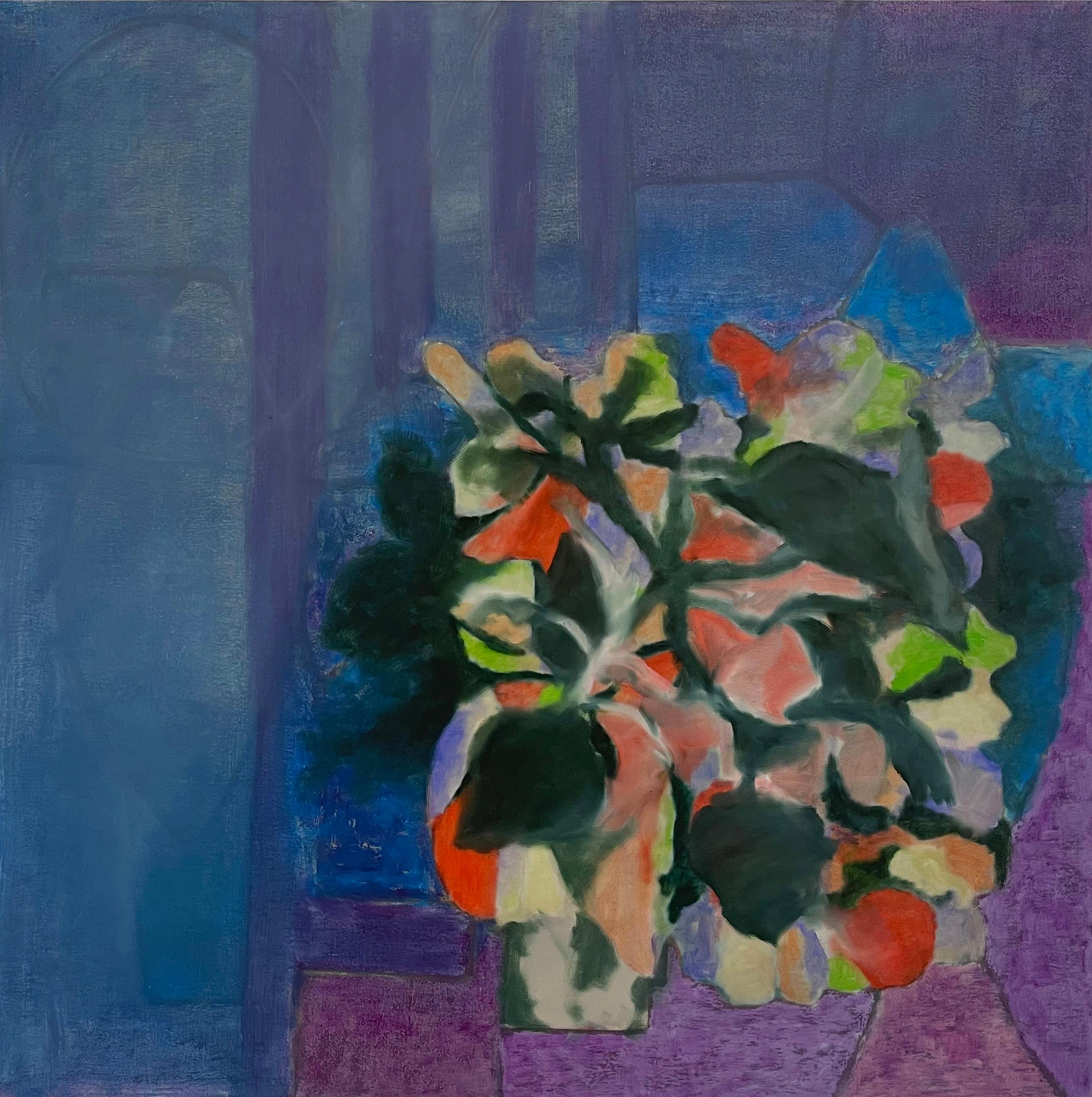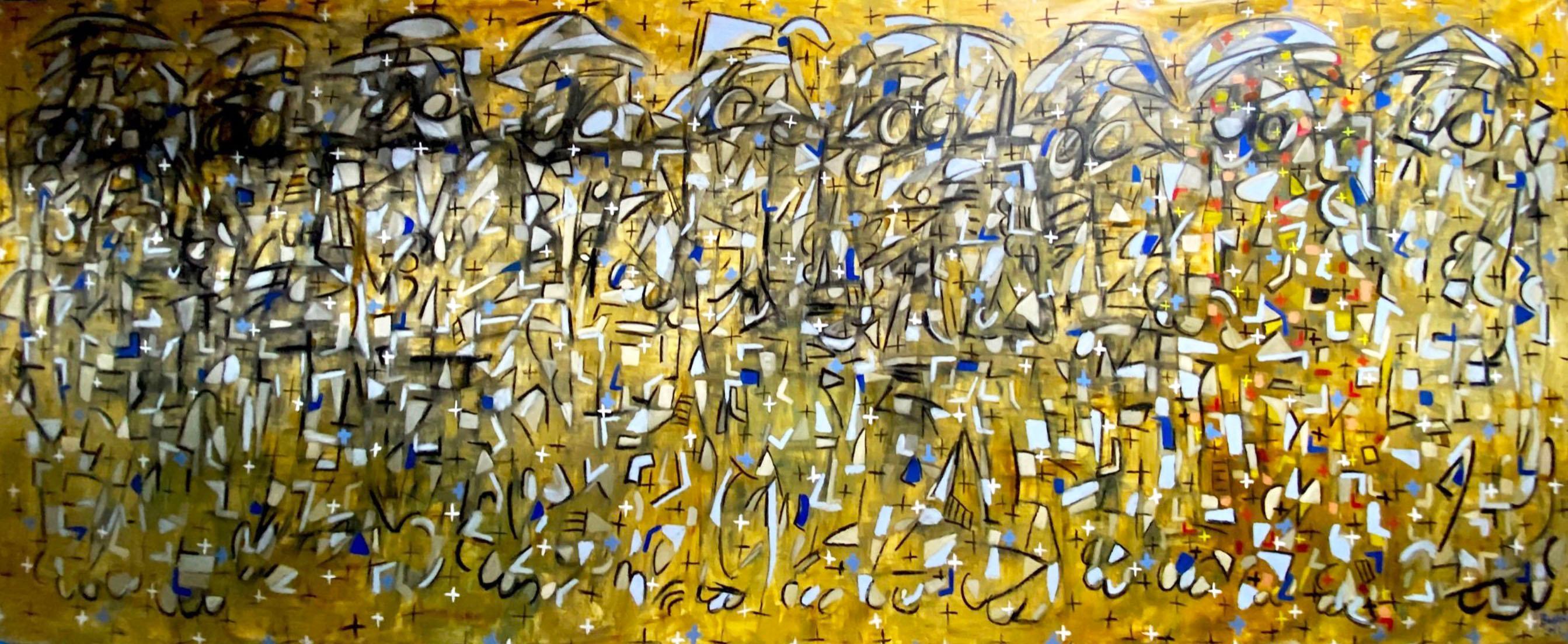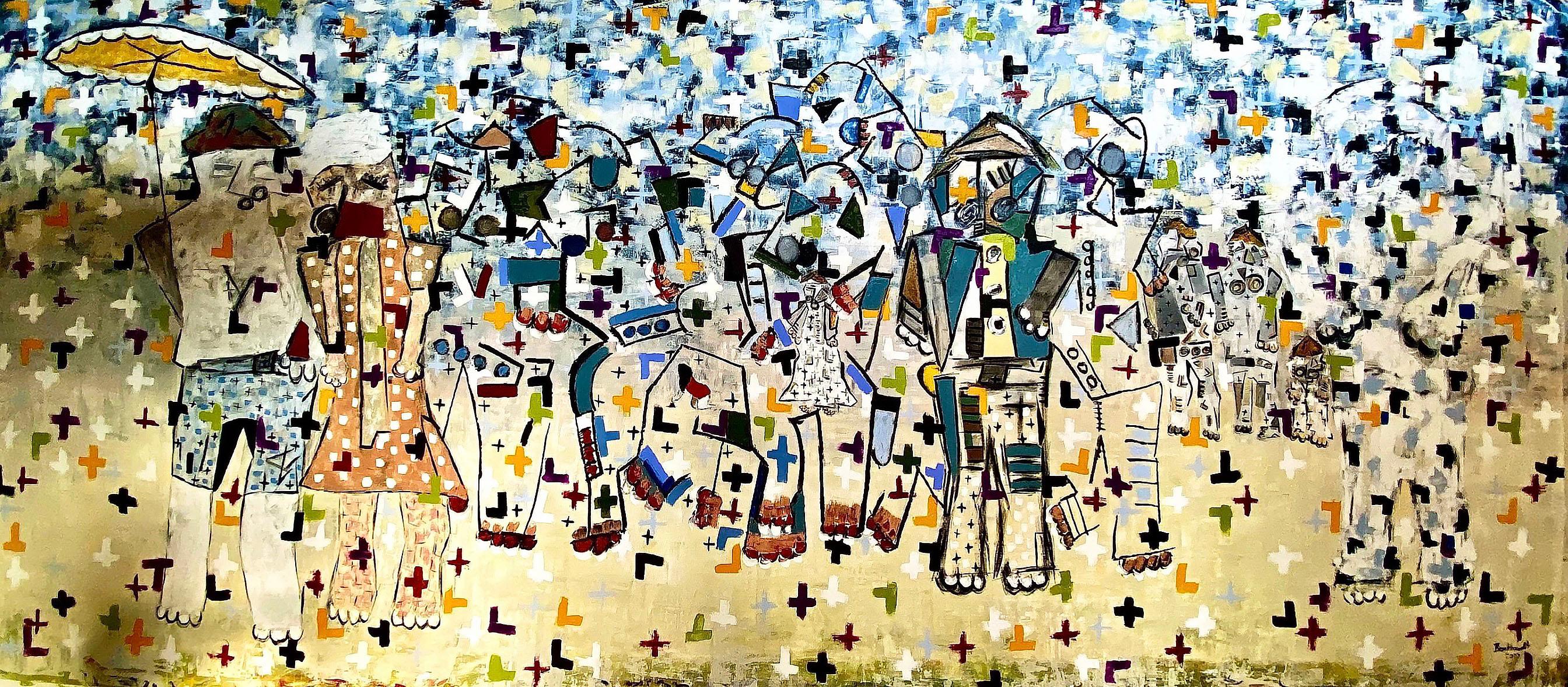Items Similar to Scottish Abstract - Exhibited 1965 Abstract Expressionist art oil painting
Want more images or videos?
Request additional images or videos from the seller
1 of 17
Jack KnoxScottish Abstract - Exhibited 1965 Abstract Expressionist art oil painting 1964
1964
About the Item
This very striking exhibited Scottish Abstract oil painting is by influential Scottish artist Jack Knox. Painted in 1964, it is a vivid mix of autumnal colours, textures and brushwork that work perfectly. A brilliant example of his work from the early sixties and which was exhibited at the Royal Scottish Academy in 1965.
Titled and dated 21.2.64 lower right.
Provenance. Exhibited Royal Scottish Academy, Exhibition 1965, Edinburgh.
Condition. Oil on canvas, 51 inches by 36 inches unframed and in good condition.
Housed in a gilt sixties surround frame, 53 inches by 38 inches framed and in good condition.
Jack Knox RSA (1936-2015) was one of the most influential artists to work in Scotland in the second half of the twentieth century. Born John Knox to a family of tailors in Kirkintilloch, Knox studied at the Glasgow School of Art (1953-57) where his drawings were noted for their mature draughtsmanship. After graduating, Knox went to Paris to attend the atelier of Cubist artist, André L’Hȏte. During his time in Europe Knox digested the various art movements of the moment, including Surrealism, Tachisme, Colour Field and Pop Art. Visiting the great museums, he was particularly interested in Analytic Cubism and Georges Braque’s intimation, rather than description, of object. He also went to Brussels to visit the first major show of American Abstract Expressionism in Europe. He returned to Scotland eager to establish his own style, drawing on everything he had seen in Europe. In 1960 the Glasgow Herald presented an exhibition during the Edinburgh Festival of young artists from the west of Scotland. Knox was selected to show alongside George Devlin, Carole Gibbons, Anda Patterson, Douglas Abercrombie and Duncan Shanks. Knox’s paintings included in the exhibition, undertaken whilst he was living and working in Rothesay, show the influence of the Abstract Expressionists and Colour Field painting during these early years of his development. Responding more enthusiastically to the optimism of American Abstract Expressionism than to the more muted French variation, Tachisme, Knox expressed his opinion that ‘this was art starting all over again’. Knox’s outlook would remain emphatically international throughout his career, drawing on divergent, multifarious influences. He would go on to participate in exhibitions in Chicago, Warsaw, Brussels, New York, Düsseldorf, Vienna, San Paolo and Sarajevo. In 1965 Knox moved from Rothesay to Carnoustie and became a lecturer in the Department of Drawing and Painting at Duncan of Jordanstone College of Art in Dundee, where he worked alongside Alberto Morrocco and David McClure. In the immediate years after leaving art school, Knox’s palette was restrained and careful but during this period he incorporated PVA into his paintings, employing the speed and confidence needed to work with the material. Knox’s imagery during the 1960s was strong and individual but focused on subjects found in his immediate domestic surroundings. Recurring shapes and motifs emerge and everyday objects obtain philosophical importance. In 1966 Knox has his first major solo exhibition at Aitken Dott’s Scottish Gallery, Edinburgh. Reviewing the exhibition in the Glasgow Herald, Cordelia Oliver wrote that ‘at times there is a sense that everything is rushing off at tangents so that only the firm canvas edge holds the warring or escaping elements in place’. Knox’s style developed rapidly over the course of his career. One critic remarked that he initially intensely disliked Knox’s work but, just as he began to like it, he found that the artist had changed to another style. Every time he warmed to Knox, the critic complained, he had changed his style. Despite the frequent stylistic shifts, Knox’s output across the decades is united by an urge to make connections between elements which are seemingly unrelated and to let ‘things coexist on the canvas’. Standing outside of art movements, Knox took his own path along his stylistic journey. One of the most important developments in Knox’s style came about in 1972 when he took a group of students to Amsterdam and saw an exhibition of Colour Field painting at the Stedelijk Museum, including paintings by Morris Louis and Kenneth Noland. Although it had been formative in his early career, Colour Field now seemed old fashioned to Knox and he left the exhibition dissatisfied. During the same visit, he was revived at the Rijksmuseum by the seventeenth-century Dutch still lifes before going down to the museum café and, ironically, finding inspiration in the cheeses, hamburgers and beer for sale. Returning home, Knox began to paint scenes of food and drink with a sturdy two-dimensionality, adapting the Dutch realist tradition to anti-Modernist ends. Attracted to the opposition of textures in these scenes, Knox painted baskets of fruit with the woven material of the basket contrasting the smoothness of the fruit. This interest in domestic still lifes would continue for the rest of Knox’s life. He obsessively re-used objects to present a cornucopia resplendent with vitality and vibrancy. In 1981 Knox moved back to the west coast and was appointed Head of Drawing and Painting at Glasgow School of Art. He worked in the spacious studio assigned to his post in the historic Mackintosh Building. Knox placed particular importance on careful drawing and instilled this in his students. He is remembered fondly by a generation of artists he tutored, a group of whom would later be dubbed the New Glasgow Boys. Knox taught at GSA until he retired in 1992. In 2004 he set up home and studio in Broughty Ferry, near Dundee, with his wife, Margaret, where he continued to work until his death in 2015.
- Creator:Jack Knox (1936 - 2015)
- Creation Year:1964
- Dimensions:Height: 53 in (134.62 cm)Width: 38 in (96.52 cm)Depth: 2 in (5.08 cm)
- Medium:
- Movement & Style:
- Period:
- Condition:
- Gallery Location:London, GB
- Reference Number:1stDibs: LU853113195232
About the Seller
5.0
Platinum Seller
These expertly vetted sellers are 1stDibs' most experienced sellers and are rated highest by our customers.
1stDibs seller since 2018
402 sales on 1stDibs
Typical response time: 1 hour
- ShippingRetrieving quote...Ships From: London, United Kingdom
- Return PolicyA return for this item may be initiated within 14 days of delivery.
More From This SellerView All
- Red Abstract - British 1960 abstract art oil paintingBy Peter L. FieldLocated in London, GBThis vibrant British abstract is by noted artist Peter L Field. Painted circa 1960, the composition in reds has relief sculptural impasto. The red works ...Category
1960s Abstract Abstract Paintings
MaterialsOil
- Surveyed - Contemporary Abstract Art Digital Painting RedBy StanzaLocated in London, GBTo celebrate Stanza's three recent solo exhibitions at HNF in Paderborn Germany 2023, Deutsches Museum 2023 and Samek Art Museum USA we are pleased to present thirty of his works for...Category
2010s Abstract Abstract Paintings
MaterialsCanvas, Oil, Digital
- Red Idol - British 50's art abstract oil painting - Modernist COBRA - provenanceBy William GearLocated in London, GBAn original oil on canvas by the noted Scottish artist William Gear. A fabulous painting. One of his best and a seminal work which dates to 1959. Provenance. Douglas Foulis Art Galle...Category
1950s Abstract Abstract Paintings
MaterialsOil
- Scrambled Messages - Contemporary Abstract Art Digital Painting GreenBy StanzaLocated in London, GBTo celebrate Stanza's three recent solo exhibitions at HNF in Paderborn Germany 2023, Deutsches Museum 2023 and Samek Art Museum USA we are pleased to present thirty of his works for...Category
2010s Abstract Abstract Paintings
MaterialsCanvas, Oil, Digital
- Early Spring - Scottish Abstract Expressionist art landscape oil paintingBy William GearLocated in London, GBAn original oil on canvas by noted Scottish artist William Gear which dates to 1981. Entitled early Spring it is a vibrant and fresh art work with lovely colouring. Signed, dated and titled verso. Provenance. William Gear estate. Royal Birmingham Society of Artists 1981. Condition. Oil on canvas, 48 inches by 32 inches. Excellent condition. William Gear (1915-1997). Few British painters have played an active role in the modern abstract movement of post-war Europe. William Gear was the most passionate and committed exception. He continued the tradition of the Edinburgh-Paris axis established by J.D. Fergusson, Samuel Peploe and others, spending vital years between 1947 and 1950 living and working in Paris. Significantly, in recent years, he received the greatest acclaim in France, Germany and the Netherlands. He was born in 1915 in Methil, Fife, into a mining family; the particular landscape of "pitheads, the sea, rocks, castles, trees, storms and poverty" marked his earliest identity with a place and probably remained the most influential to his art. Years later he recalled as a schoolboy visiting the local art gallery in Kirkcaldy and seeing 12 colourful still-lifes by Peploe. Art-history lessons during student years at Edinburgh College of Art, in particular Byzantine classes under David Talbot Rice, also influenced his concern for structure. This had as much to do with the formal language of painting as sheer delight in the medium itself. Gear never missed an opportunity to show people the merits of a well-constructed painting. On a travelling scholarship in 1937, he chose to study with Fernand Leger, described by Gear as "a keystone for me, seldom abstract, rather a degree of abstraction". The Second World War interrupted these formative years and, by 1940, Gear had joined the Royal Corps of Signals. Dispatched to the Middle East, he still had the discipline to paint - mostly works on paper of damaged landscapes - with exhibitions in Jerusalem, Tel Aviv, Cairo as well as Siena and Florence. His naturally robust and tenacious temperament was profoundly affected by visiting Bergen-Belsen, and this certainly influenced the later experiments with the black armature. As the British officer in Celle, working for the Monuments, Fine Arts and Archives Section of the Control Commission, he focused on securing the safety of the Berlin Art Collection in Schloss Celle, and organised an important series of modern art exhibitions, including the rejected work of Karl Otto Gotz...Category
20th Century Abstract Expressionist Abstract Paintings
MaterialsOil
- The Complexity of Living - Contemporary Abstract Art Oil PaintingBy StanzaLocated in London, GBTo celebrate Stanza's three recent solo exhibitions at HNF in Paderborn Germany 2023, Deutsches Museum 2023 and Samek Art Museum USA we are pleased to present thirty of his works for...Category
2010s Abstract Abstract Paintings
MaterialsOil
You May Also Like
- The FamilyLocated in Miami, FLJohannes Boekhoudt is a Dutch artist born on October 20, 1966. In 1973, Boekhoudt immigrated with his parents to Costa Rica, eventually working as a commercial and air ambulance pilo...Category
2010s Abstract Abstract Paintings
MaterialsLinen, Oil
- Uniform Language "Camo" 52 paintingsBy Stephanie PeekLocated in Burlingame, CAStephanie Peek's "Uniform Language" Camo paintings showcasing an assortment of worldwide camouflage (both historic and contemporary) from countries around the world. The complete installation includes 52 original works that are each 10 x 10 inches. Can be hung in an assortment of ways. The artwork comes with a template for installation as shown below. The series started following 9/11 with the bombing of the World Trade Center in NY. and continues to today. Stephanie Peek's "Uniform Language" is a constellation of small painting on alabaster-coated wood panels featuring camouflage patterns of nations worldwide. Peek’s fascination with these patterns stems from her observation of nature (including her studies of flowers, for which the artist is well known), and compositions of shapes and color relationships. When hung in the configuration shown, the overall dimension is 77 inches tall x 132 inches wide. The artwork can hang in a variety of configurations. Each camp painting is 10 x 10 inches. Fascinated by how various countries use camouflage patterns to represent and to disguise themselves and their military equipment, the artist explores how countries see themselves in this pattern language that speaks of power and fear, while also considering each painting a prayer for peace. Artist's statement, Early in the 20th century, the United States military adapted the nature studies of American painter Abbot Thayer...Category
21st Century and Contemporary Abstract Abstract Paintings
MaterialsAlabaster
- EscandaloLocated in Miami, FLJohannes Boekhoudt is a Dutch artist born on October 20, 1966. In 1973, Boekhoudt immigrated with his parents to Costa Rica, eventually working as a commercial and air ambulance pilo...Category
2010s Abstract Abstract Paintings
MaterialsOil, Canvas
- Still Life- Abstract Floral Geometric Contemporary Modern Oil Painting on CanvasLocated in New York, NYMedium Sized Floral Abstract Geometric Oil Painting on Canvas. BIO: Carrie Johnson was born in Kansas City, Missouri, and grew up in the Chicago subur...Category
21st Century and Contemporary Abstract Abstract Paintings
MaterialsCanvas, Oil
- AmistadesLocated in Miami, FLJohannes Boekhoudt is a Dutch artist born on October 20, 1966. In 1973, Boekhoudt immigrated with his parents to Costa Rica, eventually working as a commercial and air ambulance pilo...Category
2010s Abstract Abstract Paintings
MaterialsOil, Linen
- FantasyLocated in Miami, FLJohannes Boekhoudt is a Dutch artist born on October 20, 1966. In 1973, Boekhoudt immigrated with his parents to Costa Rica, eventually working as a commercial and air ambulance pilo...Category
2010s Abstract Abstract Paintings
MaterialsLinen, Oil
Recently Viewed
View AllMore Ways To Browse
Tailor Art
The Tailor Art
Art Cubism Painting
Abstract Cubism
Scotland Painting
Oil Painting 1964
Oil Paintings From 1964
Scottish Royal
Abstract Cubism Paintings
Scottish Oil Paintings
Oil Painting Scotland
Food Vintage Art
Abstract Warm Oil
Oil Paintings Of Scotland
Set Of Two Abstract Paintings
Dated 2004 Art
Amsterdam Oil Painting
Oil Painting Amsterdam





